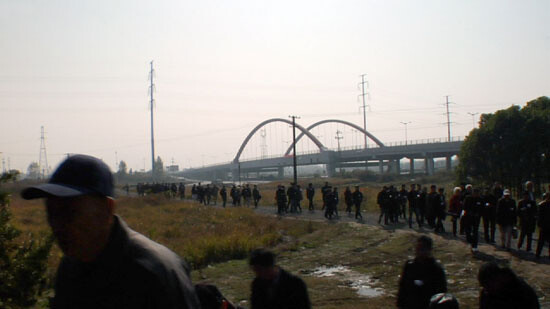Continued from “From Guilt to Sickness, Part I: Looking for Plague in All the Right Places”
November 18, 2012: Unity is Strength
Today we will commemorate the seventieth anniversary of a biological weapons attack on Chongshan, a village near the city of Yiwu. I am not as rested as I would like to be, since I know this will be a long day of carrying heavy equipment.
The night before, my roommate, Professor J., excitedly showed me video clips of what he called the real “qi gong.” Nobody was “qi gonging” anybody in the face or head, so I quickly lost interest. Since the Professor is a Maoist, I asked him about the Great Famine and the millions of Chinese who died as a result of Mao’s policies. He admitted that mistakes were made and that many people died, but he said a lot of what I had read or heard was hyperbole or anti-Mao, anti-China propaganda. He assured me that the numbers must be a lot lower than tens of millions. He also acknowledged the stupidity of the Cultural Revolution and the serious social problems China still faces. As a professor of sociology who makes about 7000 RMB/$1100 USD per month, it is his job to analyze ongoing social problems in China. He said he harbored neither hate nor love for the United States, but he loathed US interference in Chinese affairs. For him, China must solve its own problems and is perfectly capable of doing so without American meddling. He put it quite simply: China doesn’t want to be pushed around or bullied by the US.
I find this a strange song to sing in the company of the Japanese. But the lyrics would make great motivational posters.
His Chinese cigarettes made him cough most of the night, so he took some kind of pills to suppress it. He gave me some, but since the bottle they came in had no label, I had no idea what they were. I refused to swallow them. Still, I thought the pills might also quell the gag reflex I get from cheap Chinese cigarettes.
Located in an old Confucian temple, the Yiwu/Chongshan Biological Warfare Museum will host the commemoration. Survivors, victims, representatives, and journalists will all be in attendance. The Japanese will be the most important guests.
We drive through the mist of a cold Sunday morning and arrive at a bustling farmer’s market in front of the temple. Villagers crowd the street and numerous stalls line the edge of the narrow road. Slowly and with liberal use of the horn, the driver brings us to the temple without a scratch on the car or any pedestrian.
Cameras ready, the commemoration begins. I see a lot of familiar but older faces. W.X. speaks in Mandarin—the Yiwu/Chongshan dialect—and Japanese. She introduces the speakers, who take turns summarizing what still needs to be done about Japanese biological warfare in China. Some of the survivors strain to get a better view. Some seem bored. Conversations can be heard in the back, and occasionally a rooster disturbs the solemnity. This is an ad hoc event, not a governmental affair, so it’s a bit chaotic. There are no Westerners present except for me. I enjoy their absence.
After the speeches, we prepare to march to nearby Linshangsi Temple, which was seized by the Japanese and converted into an improvised vivisection laboratory. Members of Unit 731 and Unit 1644 kidnapped villagers and farmers, infected them with various toxins, and then vivisected them alive in the temple, or sometimes outside.1
Not knowing anything about the history of the area, one would be hard-pressed to guess that this was the site of a Japanese germ weapons attack. It looks like a typical Chinese village, with dirt roads, brick houses, wandering chickens and geese, hanging clothes, and numerous Chinese peasant families. But seventy years ago, hundreds of villagers were killed by plague and many others by Japanese gunshots, bayonet thrusts, and burning. As described by an Agence France Press reporter,
At its peak that terrible November, the plague here was killing twenty Chinese a day, all of them civilians. Their screams sundered the night from behind shuttered windows and bolted doors, and some of the most delirious victims ran or crawled down the narrow alleyways to gulp putrid water from open sewers in vain attempts to vanquish the septic fire that was consuming them. They died excruciating deaths.2
Carrying wreaths, the hundred or so of us walk the dirt road, past the new highway, and toward the Linshangsi Temple on a nearby hill. It’s on this march that I capture perhaps the best shots of the whole expedition. From the point of view afforded by the lower part of the temple, the slow, wreath-bearing procession against a backdrop of a modern Chinese highway bridge reminds me of the first foggy shots from Werner Herzog’s Aguirre, the Wrath of God. I am confident this shot will bookend anything I produce about this trip.
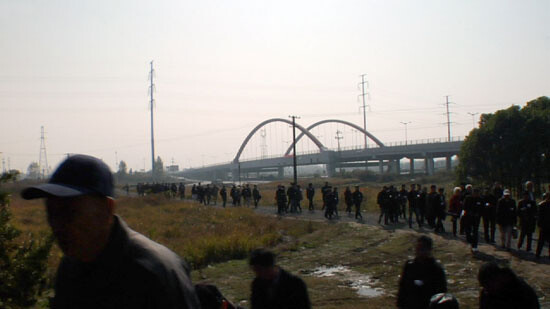

After paying their respects to the victims, the mourners break into a patriotic Chinese song from the time of the Japanese invasion called “Unity is Strength”:
团结就是力量, Unity is Strength,
团结就是力量, Unity is Strength,
这力量是铁, This strength is iron,
这力量是钢, This force is steel,
比铁还硬, Harder than iron,
比钢还强, Stronger than steel,
向着法西斯帝开火, Open fire on the fascist emperor,
让一切不民主的制度死亡! Let all undemocratic systems die!
向着太阳, Toward the sun,
向着自由, Toward freedom,
向着新中国, Toward the new China,
发出万丈光芒! Shine with boundless radiance!
After a quick lunch cooked by temple staff, the biological warfare representatives from different provinces and cities confer about the future prospects of the movement. They report on new investigations (which are few), government assistance (which is nonexistent), and promotion (of which there is little, if any). W.X. is frustrated that the other representatives, out of fear of government authorities, won’t support her bid to start an official NGO. However, the very definition of an NGO seems antithetical to the existence and power of the Chinese Communist Party. Even though a few environmental and health-related NGOs are allowed to function in China, most never receive official permission from the authorities and must establish themselves in other countries or territories, such as Hong Kong. The Chinese authorities had already quashed W.X.’s bid to start an NGO for biological warfare victims. The government doesn’t support her, and her fellow biological weapons representatives won’t either. I tell her to try in Hong Kong, the US, or even Taiwan, but she is adamant that an NGO for Chinese victims of Japanese biological warfare must be based in China.
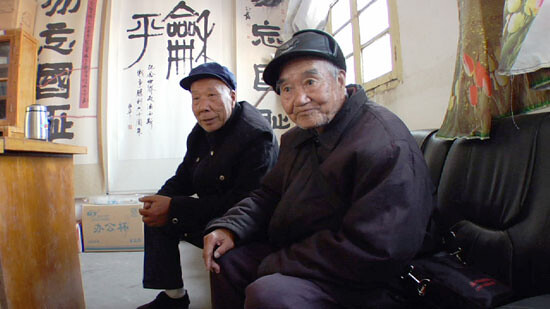

The conference is far too crowded, and I leave to survey the grounds. I encounter two elderly plague survivors and set up my camera for an interview. The younger survivor, at only seventy-four, watched three of his family members die, and he can still picture the festering facial blisters on one of the victims. The older survivor was fourteen when the Japanese attacked in 1942. When a lymph gland near his groin painfully swelled, his mother used a needle to burst the bubo. His memory is clear and his voice is strong as he points to his crotch and describes the puncturing, oozing, and subsequent cleansing with distilled liquor. They both still remember the Japanese plane spraying the area with germs, and they both clearly recall the Japanese soldiers in Imperial Army uniforms. Although I had already met them years before, they don’t remember me. I ask them if they still hate the Japanese. Of course they do. I remind them that five Japanese are sitting in the conference room next door. They know, but distinctions must be made. They state it in the most trivial way: “Some Japanese are bad, and some are good.” I ask them if they can ever forgive the Japanese. They don’t answer. The younger man responds that the Japanese must apologize with sincerity, but, as the older survivor chimes in, they must also pay reparations. How much? No answer. It just cannot be minuscule. Too little would constitute another insult.
They lead me to a memorial wall for local victims. I recognize many of the faces. I interviewed some of them a few years ago. I’ve eaten with some of them. A few are in my previous documentary, Lessons of the Blood. Many have died in the interim. There’s no past tense with death—once you’re dead, you’re always dead in the present. It’s a chilling experience to see these pictures and be reminded of the faces and voices of the victims. I appreciated their indomitable will to live. I realize I will never see some of these people again. I think that whatever it is I am doing, it’s pointless. I can’t really help them. I’m not an activist.
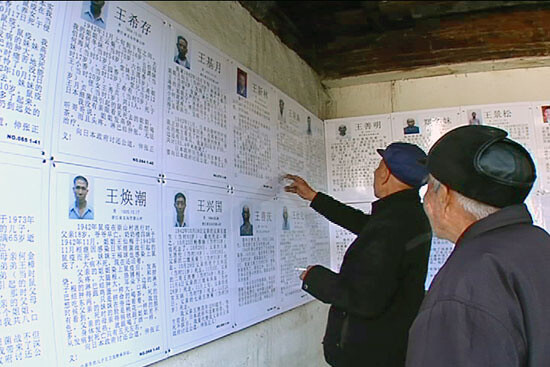

November 19, 2012: No Forgiveness
The next morning we take a public bus to the city of Quzhou for a visit to the local biological warfare museum. I’m surprised that some Westerners have signed the guestbook, as a germ warfare site isn’t usually a local tourist attraction (though it is in Harbin/Pingfan, the former headquarters of Unit 731). Moreover, Quzhou isn’t exactly a top-notch vacation spot, or at least it wasn’t in my memories of the place.
A Unit 731 plane carrying a mixture of infected wheat, millet, and fleas first sprayed Quzhou in 1940, which lead to an outbreak of plague. The epidemic was contained but recurred in 1941. Allegedly, around 50,000 people died from the plague and other Unit 731 contagions during the first six-year period after the initial 1940 attack.3 The plague was still killing people after the war officially ended.
Touring the old part of Quzhou near the museum, we find that many of the local temples are being renovated. At least some of the city’s new wealth has gone to renewal and repair instead of creative destruction.
The museum has big plans. The director, a victim himself, shows us the planning guide for the revamped museum. It’s filled with impressive computer mockups of interactive video exhibits, adjustable track lighting, and meticulous museum displays. The current displays are showing their age. I find my signature occupying a part of a pitiable vitrine because I was one of the very few foreigners to take an interest in the place.
Before we finish our Quzhou tour and say our goodbyes to the Chinese professors and most of the Japanese faction, I finally get a chance to sit down and interview S.K., the Japanese documentary producer.
Me: Why are you interested in Japanese biological warfare?
S.K.: Because biological warfare is a national secret.
Me: Why this secret? Why not others?
S.K.: Because this is a unique, large-scale secret.
Me: Do you feel guilty about what the Japanese military did?
S.K.: Yes.
Me: How about your parents?
S.K.: My father was stationed in Mudanjiang (known in Japanese as “Botankuo”) in Manchuria. He must have felt some guilt, because he didn’t talk much about the war. But I remember very clearly, when I was still very young, he talked about hiding in the grass from the Russians. There was little cover, and he wanted to hide. I felt that he must have done something wrong—something wrong that made him want to hide.
Me: Do you think the Chinese victims can forgive the Japanese for biological warfare?
S.K.: No.
Me: Do you want to be forgiven?
S.K.: I don’t expect any forgiveness from the victims. They might show some understanding, but I expect no forgiveness.
Me: Why doesn’t the Japanese government apologize about germ warfare and just be done with the problem?
S.K.: There are two issues. First, Japan is close to the United States. Second, an apology would hurt Japanese pride.
Me: That’s all? That’s it?
S.K.: Because the crimes were so cruel, so inhumane, were the Japanese to apologize, it would hurt the Japanese tribe, the Japanese race.
Me: How come Germany can apologize and get some respect for their apologies while Japan cannot?
S.K.: The Germans could not hide what they did. Japan, with the United States, hid biological warfare, and since they have hidden it for so long, the Japanese government still sees the issue as something that will always be hidden.
In Karl Jaspers’s terminology, S.K. feels political, moral, and metaphysical guilt. He also suspects that his father shared some kind of criminal guilt, which then he, as his son and not simply as a Japanese, inherited. Pride functions as a fundamental obstacle to any sort of atonement, and S.K.’s response implies that Japan is still essentially a shame-based culture. Even a Japanese right-wing-funded, cinematic rehabilitation of Hideki Tojo, who was executed for war crimes in 1948, is entitled Pride.4
For the time being, the Japanese and US governments remain politically and metaphysically guilty of conspiring to cover up Unit 731’s atrocities and of protecting and rewarding the perpetrators. However, the US has at least declassified thousands of documents relating to Japanese biological war crimes, and many of these documents implicate the US governmental authorities of the time.5 Despite the absence of any official indictment, conviction, or admission of guilt, the US can take some pride in its release of the documents.
We head to the nearby city of Jinhua, which was also barraged with biological weapons, primarily bubonic plague, in 1942. N.S., the independent Japanese researcher, is interested in finding more corroborating wartime Chinese documents and interviewing surviving witnesses. He is in his late sixties and has a heart problem, but he seems to have no trouble keeping up. His own obsessive research in Japan unearthed a number of valuable documents, which assisted W.X.’s failed lawsuit against the Japanese government. During the war, his father was drafted into the Japanese Imperial Army and served with the Signal Corps in China. Guilt has also fueled his decades-long interest and relentless fixation on Japanese biological warfare.
In Jinhua, W.X. buys me a shitload of fresh fruit. It’s good stuff, but there is no way I can eat it all in a week. She tells me that I should give some to the Changde visitors, a group of survivors/representatives from Hunan Province, which lies east of Zhejiang. They had a long train ride from Changde, and the group is excited to see Jinhua for the first time.
An important shipping and railway point, Changde was first attacked by Unit 731 in 1941. In one of a series of field tests, a Unit 731 plane dropped and sprayed bacteria-covered foodstuffs, plague-infected fleas, and other test vectors, like strips of paper, onto the city. Soon the plague and other diseases spread to surrounding villages as well.
In 1943, Changde was the site of a major military battle between Chinese and invading Japanese troops numbering in the tens of thousands. After losing the city, the Chinese were able to surround the invaders, cut off their supply lines, and force them to withdraw. During the retreat, Unit 731 agents disseminated plague and mistakenly infected many of their own soldiers. The 1943 Battle of Changde is considered a decisive Chinese victory against the Imperial Japanese Army.
One of the members of the Changde group is my roommate, and I’m waiting around in our room to give him and his companions the extra fruit. They arrive around 1 a.m., boisterous and energized by their wanderings around the unfamiliar city. I assume that they are at least modestly drunk, but it turns out that none of them drinks alcohol, and they turn on the TV and invite me for tea. While chatting they spill cigarette ashes, sunflower seed shells, and fruit remains all over the floor, which is now sticky and grimy. The bathroom has a good bit of urine and spittle around the toilet. Thinking about the hotel staff, I feel some moral guilt, so I try to clean up a bit.
My roommate is an elderly plague survivor in his eighties—in all respects a friendly fellow—but his intermittent snoring is much louder than my clock’s alarm. Finding it unbearable, I stuff tissues into my ears and even throw my pillow at him. Again feeling a bit of moral guilt, this time at attempting to disturb an old man’s sleep—a plague victim no less—I go downstairs to the lobby and try to get another room. My passport has already been used for one room, so I am out of luck. I return with a large beer, down it in a minute, and hope for two hours of sleep at best. The long days and little rest are starting to add up.
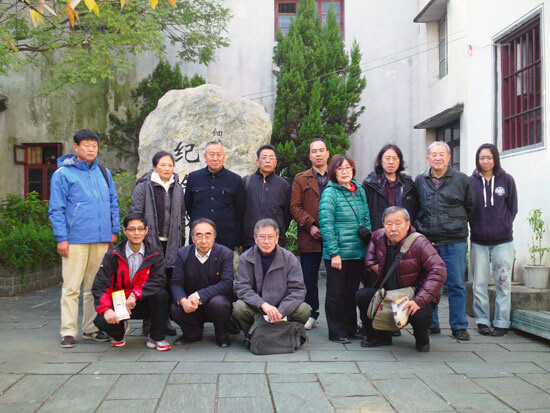

November 20, 2012: Never Forget
Early in the morning we go to Jinhua city hall, a typically imposing Communist Party building. Security requires that all visitors swipe their Chinese identity cards, so W.X. tells one of the guards that she’s swiping my card and the Japanese researcher’s card for us. As foreigners, N.S. and I don’t have Chinese identity cards.
I’m rather excited to be in a place where I am not supposed to be, but the city hall ends up being rather dreary, like any other bureaucratic edifice. W.X. has brought us here to find some officials who might be able to help us with the investigation. For her years of tireless efforts at documenting biological warfare victims and for representing the survivors during the failed 1997 Japanese court case, W.X. has become a minor celebrity in China, or at least in the province. Some local government officials sympathize with her mission and understand the plight of the victims. Not every government official is an evil corrupt asshole.
After the meeting, one of W.X.’s newly rich, distant relatives takes us to a swanky restaurant for an early lunch. It seems that every person who shares her surname in this province is a relative of hers. He treats us to a variety of local Jinhua delicacies. One of these is a large bone broken in half and presented with a straw. The relative urges N.S. and me, the two foreigners, to try it. I ask him why he doesn’t, but he just replies that he can’t. It’s definitely interesting, and I’ve never eaten bone marrow in such a fashion, so I’m tempted. Everyone at the table stares at me while I consider my next course of action. N.S. doesn’t touch his bone. Unable to resist the social pressure and my own curiosity, I insert the straw and suck. I will remember that taste forever, because it proved to be my undoing.
With N.S.’s rigorous research and local maps, we can pinpoint the exact locations around Jinhua of the plague outbreaks that occurred seventy years ago. W.X.’s relative chauffeurs us to one of the villages on the outskirts of the city. Many of the rural villages in Zhejiang Province look quite similar. Newer, more modern dwellings are constantly under construction, and expensive cars dot the main thoroughfares. We park near a community center swarming with senior citizens, and, as it happens, flies. With a lot of old people around, we should be able to find someone who can detail the wartime plague outbreaks.
I had been to more than a few rural Chinese villages, and I knew what to expect, but the filth in this particular village was shocking. Spit stains, dog shit, and garbage littered the ground, while the open air reeked of a trash bin. Since these villages probably don’t receive many newcomers, our crew, which now included some Jinhua reporters, attracted all the attention. A crowd of perhaps every local resident soon surrounded us, making filming and interviewing difficult, especially with all the chatter. Even the stray dogs were curious to sniff us.
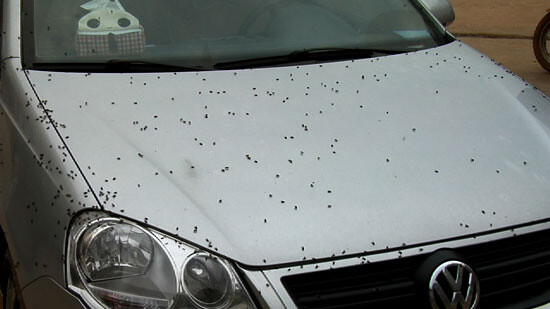

The locals go and fetch the oldest residents. We ask them specific questions, as we usually do during these investigations, and some of them show us their wounds and scars, which N.S. guesses are from plague. As I understand it, bubonic plague doesn’t usually leave visible scars, and these wounds don’t look specific. Moreover, none of them were as severe as the cutaneous anthrax and glanders wounds that I had seen in other parts of Zhejiang, especially around Jiangshan and Quzhou. We write down a few names, get some birthdates, and prepare for another village. We don’t have a lot of time today, and the testimonies we hear in this village simply aren’t detailed enough for our current investigation. W.X. will send some students here for further research.
An old woman wanders into our group and interrupts a few of my shots. She seems angry and disappointed that we don’t spend more time interviewing her. I feel a twinge of guilt. Maybe she needs some kind of help. Maybe she needs money. Maybe she no longer has any living relatives, and nobody talks to her.
We arrive at another village and interview an octogenarian who remembers the Japanese clearly. He describes the Japanese planes mowing down fleeing villagers, and the beatings inflicted upon himself and others after being enslaved by Japanese troops. Sniffling and staring at N.S., now the lone Japanese in the room, he recalls five Chinese laborers bound to poles in front of the local school. They had begged the old man, then a twelve-year-old boy, to untie them, but he was simply too afraid. The victims were ultimately bayoneted to death as an example to the rest of the villagers. He doesn’t remember any of their names. They might be lost to history. He also doesn’t remember seeing any Japanese in white lab coats, and he can’t recall anything about the epidemics. Facing our cameras, the old man tried to stifle his metaphysical guilt.
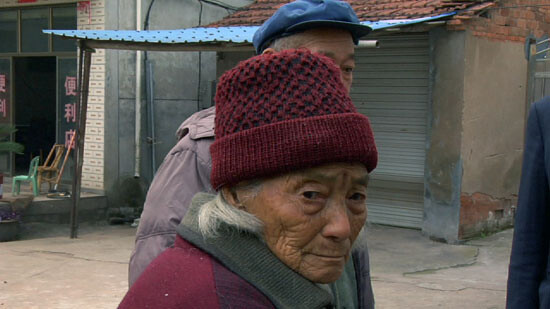

We tour the village and visit a building the Japanese established as an improvised comfort station qua brothel. Zhejiang’s wealth has been slow in changing this village, so many of the buildings are preserved remarkably well here. At this point, I start feeling a little queasy, but I just write it off as fatigue.
In the hills close to the village, and near a few nondescript factories, some private Japanese companies erected a monument to Sino-Japanese friendship in the 1990s. Now neglected and overgrown with thorny weeds, the monument’s broken stone steps lead from the dirt road to a small temple topped by a sculpture of a peace dove. Neighboring obelisks dot the hill, and an inscription on one of them outlines the high costs of the monument’s construction. Seemingly out of place, the perfect setting for a horror film, the Shihua Shimen Sino-Japanese Friendship Park (金華石門中日友好林園) serves as a failed Japanese attempt at atonement, precisely because it isn’t. There is no apology, no litany of Japanese atrocities and abuses, and no list of the victims. The monument’s capitalist intentions are too visible and reek of insincerity. In the end, the park’s state of disrepair mirrors the current state of Sino-Japanese friendship.
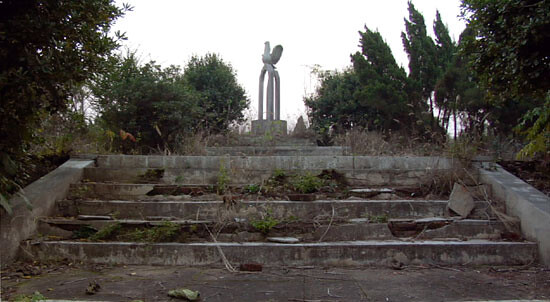

The officials whom we met earlier at city hall treat us to a friendly dinner. I’m definitely feeling sick now, so all I want to drink is orange juice. A number of people at the table tell me not to drink cold beverages. I respond that heating the orange juice will kill the vitamin C. I eat very little and quietly listen to the officials and W.X. reminisce about being “sent down” and the subsequent scarcities suffered under the Cultural Revolution. They lament that young people nowadays waste too much food and have little interest in Chinese history.
W.X. scolds me as I continue to sip my cold orange juice. Her relative argues that cold drinks are bad for anyone, Chinese or Western. I start shivering. I want their nostalgic conversation to end as quickly as possible. I think I must be getting the flu.
Back at the hotel I begin a punishing marathon of vomiting interrupted by diarrhea and the latter interrupted by the former. Fluids pour out of every orifice, including my eyes. I can’t even remember the last time I vomited—six years ago? I will never forget the taste of that bone marrow.
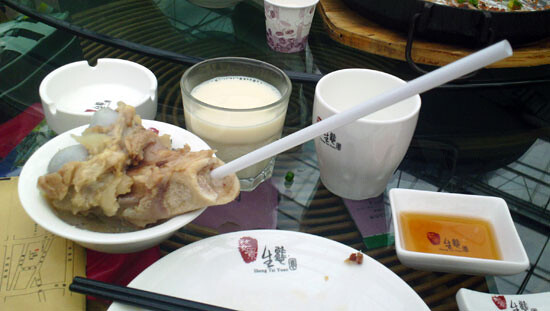

November 21, 2012
Once the intermissions between my expulsions last at least thirty minutes or so, I can finally lie in bed. During one particularly grueling episode of retching, I hear a knock at the door. I try to ignore it, but a voice comes through: “It’s the police, we are here to check your ID.” I wipe the fluids off my face, check the peephole, and, clad only in boxer shorts, open the door. I tell them I am puking. They say that it’s OK. I guess this is nothing new to them. I leave the door open and return to the toilet. After three minutes or so, the urge to expel subsides. I fetch my passport and present it to the closest Public Security Bureau officer. He opens it, confers with the other officers, and gives it back to me. They leave. I go back to bed to rest for another half an hour. Japanese biological warfare means nothing to me right now.
November 22, 2012
My memories are willfully murky. I remember W.X. and some students. Lots of medicines and antibiotics. I remember the feeling of the antibiotics surging through my blood vessels, especially in my arms.
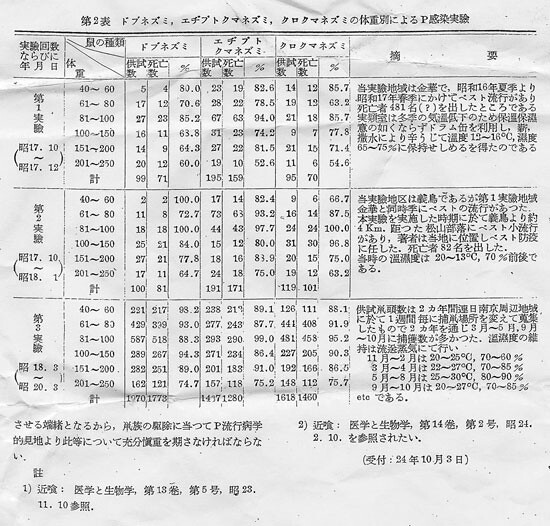

November 23, 2012: The Wanderer and His Shadow
I get enough strength to wander around the neighborhood, again reminded of Žižek’s anonymous Chinese cities. I don’t know anybody around here. None of this is familiar to me. No one casts a shadow; everyone looks the same. I can’t see any differences, because they simply don’t matter, or I can’t understand them. I am unconcerned, unabsorbed. My sickened state destroys any principle of charity, and my whole demeanor detunes. On the inside, centered in my bowels, I become the ugly American. Why do a lot of Chinese think the West is better? Because it is.
N.S. wants to spend his last few days exploring Shanghai, so we head to the train station. Even though I haven’t eaten anything in two days, my guts are still unstable, and I’m terrified of releasing a liquefied shadow of shit into my pants. I let loose in the filthy train station’s squat toilet once and then twice. I hardly have the strength to hold myself up while squatting, but the fear of falling into a pool of filth gives me just enough will to squat. Stashing tissues in my various pockets proves to be a triumph in planning. Waiting for the train, I can only observe the mingling of the rich and the poor. I stare at the people who spit on the floor. I occasionally block people trying to cut in line.
On the train I spot the first Caucasians I’ve seen in days. It’s not any kind of welcoming sight, just unexpected—two incredibly ugly Russians, probably businessmen. They have every Apple product available: two iPads, a MacBook Pro, a MacBook Air, iPhones, and more. They watch a Harrison Ford movie with headphones. Unfortunately, the elderly Chinese couple behind me isn’t so courteous. They blast a soap opera about classical Chinese opera singers. It is unbearable. I need to know exactly where the bathroom is, and how long it will take me to get there. This is my deliberative being-in-the-world as homesickness.
Daniel Barenblatt, A Plague upon Humanity: The Hidden History of Japan’s Biological Warfare Program (New York: HarperCollins Publishers, 2004), 161–62.
Quoted in Sheldon Harris, Factories of Death: Japanese Biological Warfare, 1932–1945, and the American Cover-Up(New York: Routledge, 2002), 103.
Harris, Factories of Death, 102.
Pride: Moment of Destiny (プライド 運命の瞬間), directed by Shunya Ito (Tokyo: Toei Co., Ltd., 1998).
The National Archives and Records Administration (NARA), Interagency Working Group (IWG), Washington, D.C. See →.
All images courtesy of the author.
